Menus
- High-tech versus low-tech sports motorcycle
- Royal Enfield Continental GT with a large oscillating mass
- BMW HP4 for rapid pace changes
- HP4 a machine for practiced maneuvers
- Enfield introduces the carefree side of motorcycling
- Fast, fascinating, but exhausting
- Technical specifications
- MOTORCYCLE measurements
- Measurements over the pass
- MOTORCYCLE conclusion
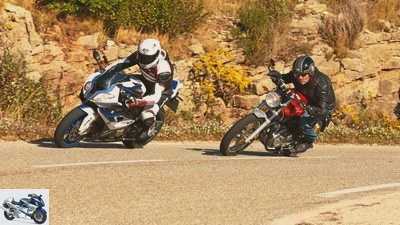
Bilski

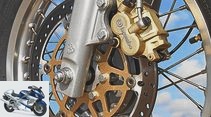
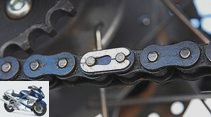
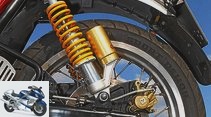
47 photos
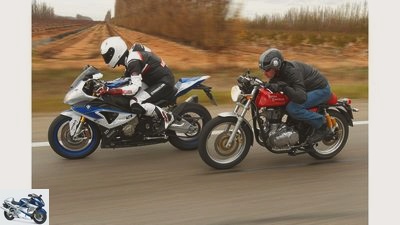
Bilski
1/47
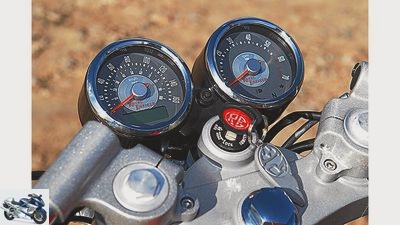
Bilski
2/47
The Royal Enfield could do without a tachometer if necessary, …
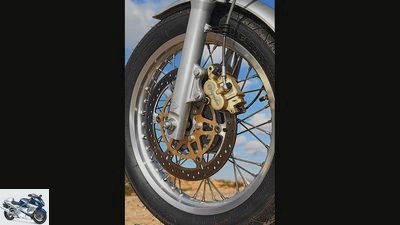
Bilski
3/47
… their double-piston floating caliper, original Brembo, decelerates bravely.

Bilski
4/47
With 28 HP, the O-ring chain still needs a clip lock, …
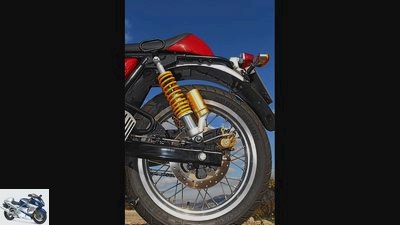
Bilski
5/47
… and the steel swing arm could hardly be made simpler.
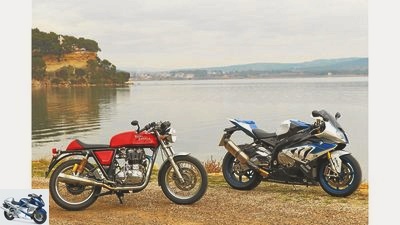
Bilski
6/47
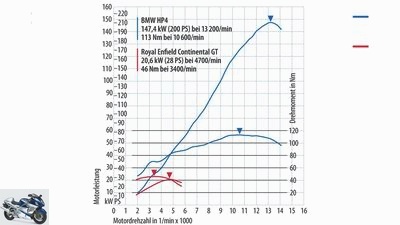
Bilski
7/47
Performance chart. Somehow cute, how the Enfield curves snuggle into the corner of the frame that the BMW has drawn out wide.
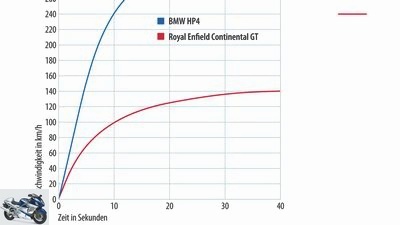
Bilski
8/47
Acceleration diagram. Actually, the performance of the Enfield is sufficient for normal road traffic.
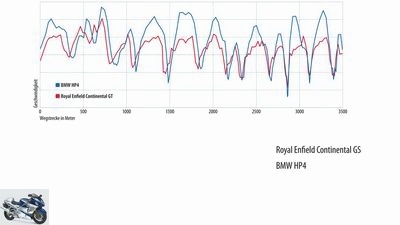
Bilski
9/47
MOTORCYCLE measurements: a pass drive (the diagram shows a section of two uphill drives on the south ramp of the Col de l’Espigoulier near Marseille).
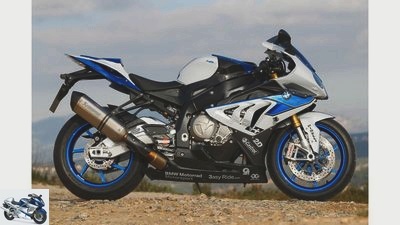
Bilski
10/47
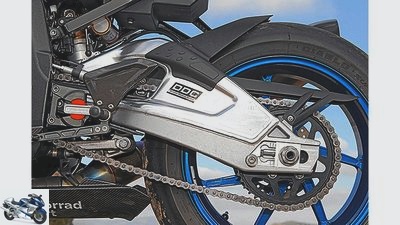
Bilski
11/47
… the mighty swing arm for stability on all levels.
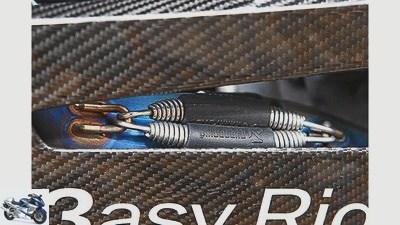
Bilski
12/47
Akrapovic stands for the finest titanium processing and …
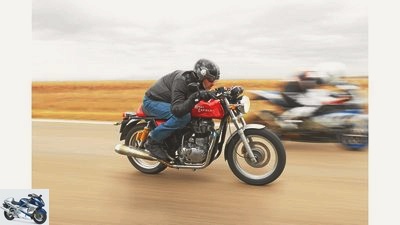
Bilski
13/47
Royal Enfield Continental GT.
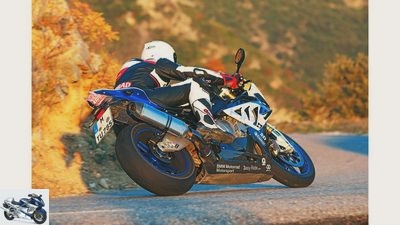
Bilski
14/47
BMW HP4: 200 hp, 299 km / h.

Bilski
15/47
Optimized in every way: high-tech four-cylinder, surrounded by titanium exhaust manifolds and carbon parts.
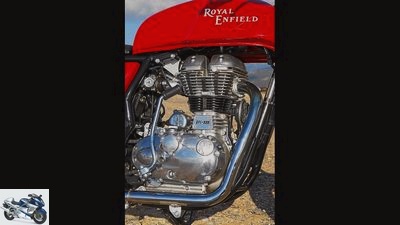
Bilski
16/47
The Royal Enfield’s nostalgic, air-cooled two-valve engine dominates its side view.
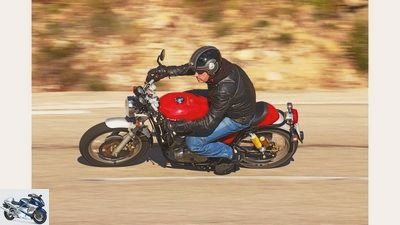
Bilski
17/47
Royal Enfield Continental GT: 28 hp, 140 km / h.
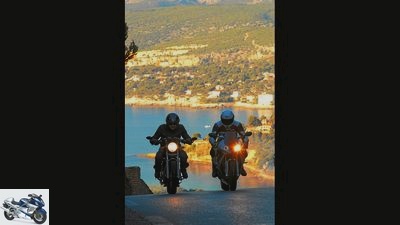
Bilski
18/47
The Enfield fits better than the ambitious BMW on the idyllic roads on the southern French coast.
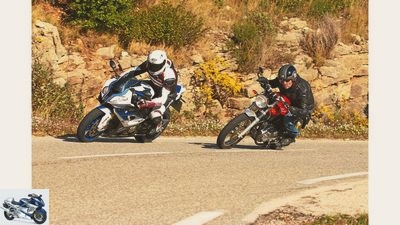
Bilski
19/47
The Enfield is so good at corners that it needs more lean angle.
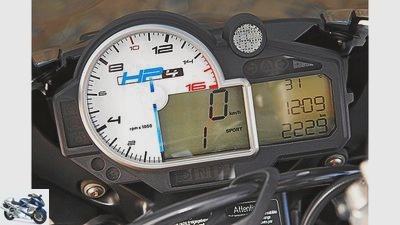
Bilski
20/47
At full power, the shift light becomes the most important display in the BMW cockpit, …
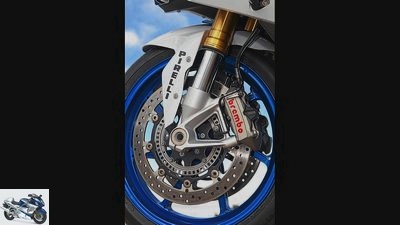
Bilski
21/47
… the Brembo fixed calipers plus ABS have to pay for it before the bend.
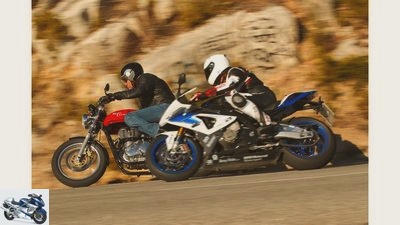
Bilski
22/47
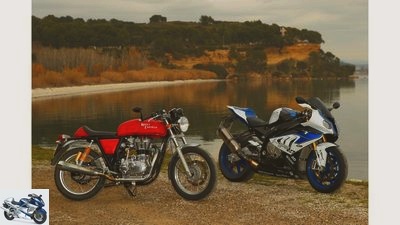
Bilski
23/47
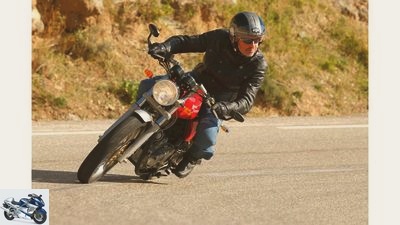
Bilski
24/47
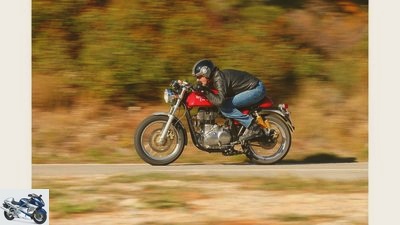
Bilski
25/47
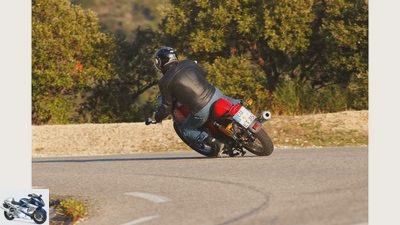
Bilski
26/47
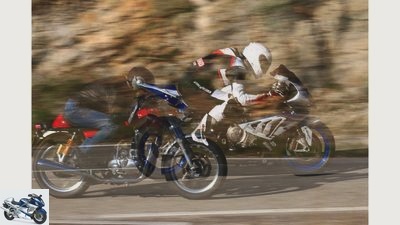
Bilski
27/47
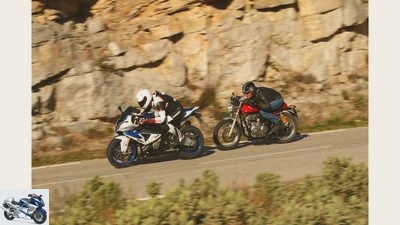
Bilski
28/47
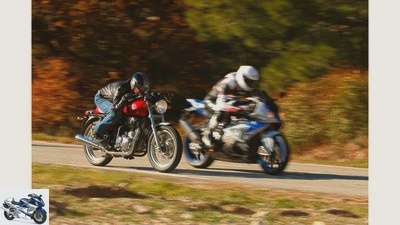
Bilski
29/47
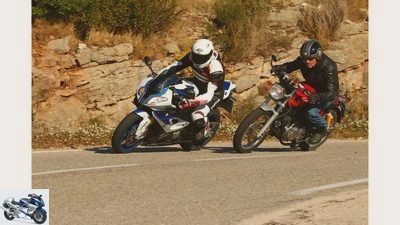
Bilski
30/47
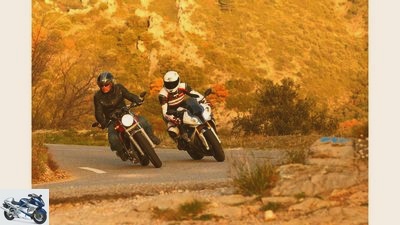
Bilski
31/47
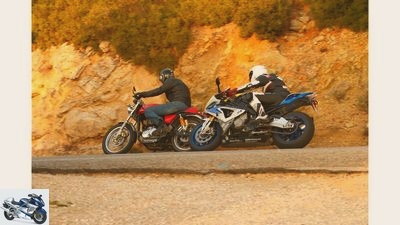
Bilski
32/47
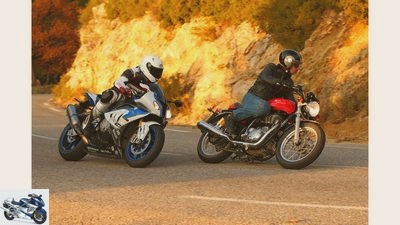
Bilski
33/47
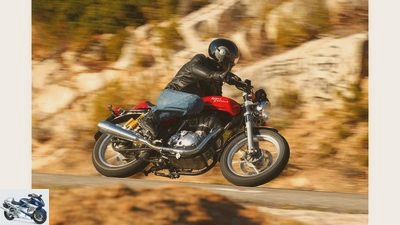
Bilski
34/47
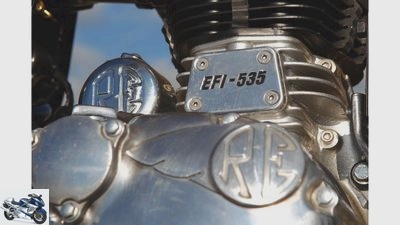
Bilski
35/47
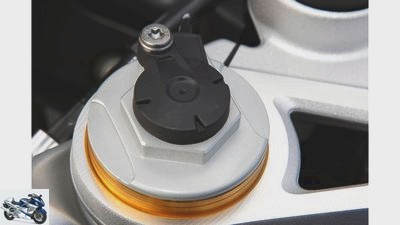
Bilski
36/47
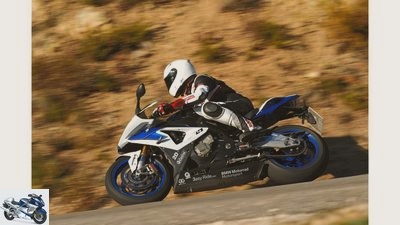
Bilski
37/47
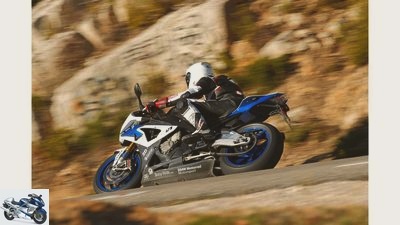
Bilski
38/47
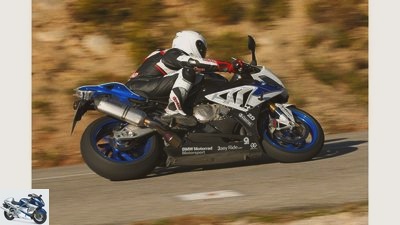
Bilski
39/47
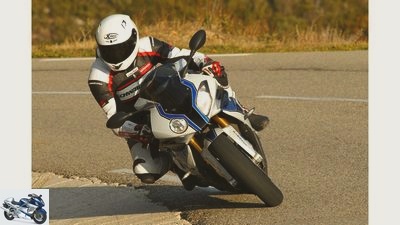
Bilski
40/47
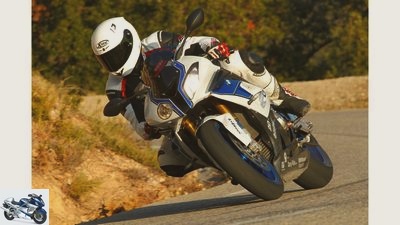
Bilski
41/47
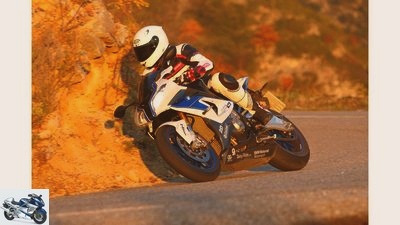
Bilski
42/47
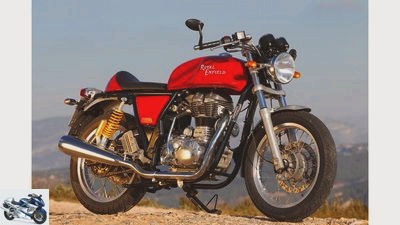
Bilski
43/47
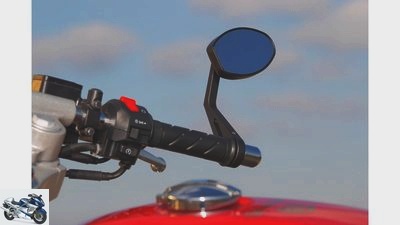
Bilski
44/47
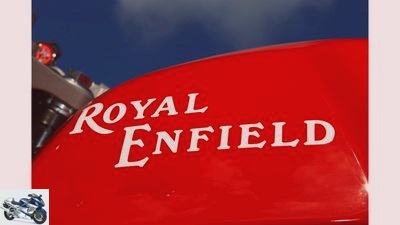
Bilski
45/47
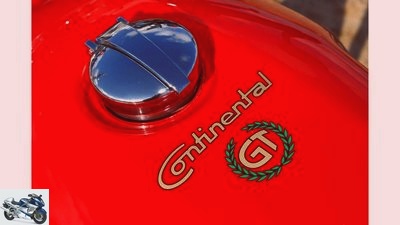
Bilski
46/47
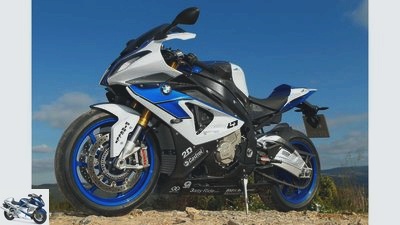
Bilski
47/47
BMW HP4 and Royal Enfield Continental GT
High-tech versus low-tech sports motorcycle
Don’t worry, MOTORRAD doesn’t fire at sparrows with cannons, not with a 200 hp HP4 at a 28 hp Enfield. For the following story, the two did not drive against each other, but with each other. And each was quick in its own way.
If the driver makes himself small in the slipstream of the ignition key, the Royal Enfield runs C.ontinental GT after a one-and-a-half kilometer run-up an incredible 140 km / h. A fully accelerated BMW HP4 catapults itself to double its speed after just 838 meters. Numbers games that illustrate the stark difference between the two. There are hardly two other current sports machines that are so fundamentally different. Both are from the present, but while the HP4 represents the state of the art in everything, the Continental GT takes us back to the 1960s.
Buy complete article
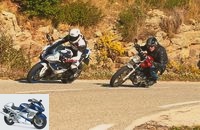
BMW HP4 and Royal Enfield Continental GT
High-tech versus low-tech sports motorcycle
Royal Enfield Continental GT still appropriate for today’s traffic situation? Or maybe again? What does it take to properly dose the grandiose overkill of the BMW HP4? In order to clarify these questions, the MOTORRAD testers drove to the south of France, stalked along the damp roads in the valleys, enjoyed the briefly flaring midday heat, crossed passes and made stretches on the motorway.
Royal Enfield Continental GT with a large oscillating mass
As already suspected in the driving report in MOTORRAD 21/2013, the Royal Enfield Continental GT turned out to be a dynamic motorcycle away from the racetrack or the test track. However, this requires the willingness to let them run quickly even on unknown routes, i.e. to take as much speed as possible into the corners and also to bring them through the corners.
Rapid changes of pace are not the thing of the Royal Enfield Continental GT. One reason for this is the engine power, which is not exactly synonymous with explosive acceleration, and another is the large flywheel mass of its 535 single-cylinder. On the one hand, it ensures flawless concentricity at low speeds and a quasi-tractor-like pulling force, but on the other hand, it is responsible for the rather slow turning up. “That’s the way it is when a crankshaft is still a crankshaft and not just a crank pin holder,” commented test boss Gert Thole on this behavior that modern motorcycles no longer know.
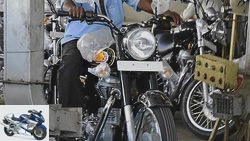
motorcycles
Report: Royal Enfield factory visit
A visit to the English cult brand
read more

Modern Classic
Royal Enfield Continental GT in the driving report
British-Indian cafe racer
read more
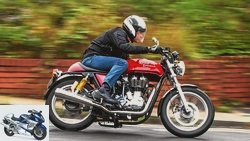
Modern Classic
Royal Enfield Continental GT in the driving report
Progress in chassis and engine technology
read more
BMW HP4 for rapid pace changes
Instead of a flywheel, the four-cylinder design of the BMW HP4 ensures smooth running at low speeds. A super-light “crank pin holder”, an optimized gas exchange and a finely devised map for ignition timing, injection quantity and throttle valve opening guarantee a high revving that is difficult to describe. The HP4 engine combines the speed of a 600 – at 14,200 rpm the limiter kicks in – with the power of a 1000. For the driver it feels as if the urge for higher revs and the associated pulling forward will never stop. On the contrary, the closer the speed gets to its limit, the harder the HP4 pushes. Because it is what the Royal Enfield Continental GT cannot be, a motorcycle for rapid pace changes.
But these are not free; they demand a willingness to make an effort. Sitting comfortably upright, banging around quickly but easily like on the Royal Enfield Continental GT, just doesn’t work with the BMW. If you want to sit up straight, stretch your arms because of the low-lying halves of the handlebars, thereby hindering yourself from sensitive steering and automatically robbing the motorcycle of any suppleness. Despite a strongly bent position, the BMW driver must try to hold as much of the weight of his upper body as possible through the leg, back and neck muscles in order to be able to steer with a light hand. And he has to shift his body towards the inside of the curve, forwards or backwards, depending on the driving situation. Not only is there always something to do – that anyway – there is always something more to do on the BMW HP4. Also because the higher speed peaks inevitably go hand in hand with higher acceleration and braking forces, which also affect the driver.
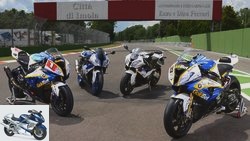
Super athlete
BMW works superbike, superstock HP4 and series HP4 in the test
Track test on the Imola slope
read more
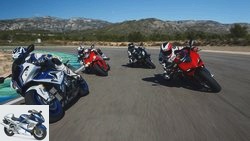
Super athlete
Test: BMW S 1000 RR against HP4 and Ducati 1199 Panigale against Panigale S.
Race track comparison: BMW and Ducati super sports cars
read more
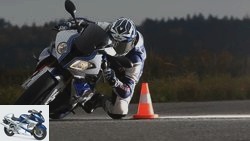
Super athlete
The further development of the BMW S 1000 RR
BMW HP4 in the top test
read more
HP4 a machine for practiced maneuvers
Bilski
BMW HP4: 200 PS, 299 km / h.
As with every photo drive, the Royal Enfield Continental GT and the BMW HP4 did not get the shots for this story straight away. Above all, the BMW demonstrated by driving through a combination of curves several times what it is all about. After having roughly learned the line and warmed up the tires, the driver made better use of the acceleration potential – and initially got himself into trouble. Because on the short, not even straight stretch of road to the next bend, the HP4 suddenly catapulted itself and its pilot forward so much that he barely managed to change the lean angle for the following right bend. The next time it worked it worked better and faster, which is why it got hooked when turning over into the next left-hand bend. It took a few tries to practice the whole sequence of maneuvers in the left-right-left combination of curves. But then it was as if a door to an exciting driving experience with the BMW HP4 had suddenly opened. Because of its irrepressible dynamism, which is still recognizable as the primary development goal in every minute detail, it must be driven very precisely. Most of us motorcyclists can only develop the necessary precision through repetitions, i.e. only on the racetrack. Basically, the HP4 is far removed from everyday traffic, a machine for practiced maneuvers and the last few percent before the absolute limit.
Enfield introduces the carefree side of motorcycling
Bilski
Royal Enfield Continental GT: 28 hp, 140 km / h.
On the other hand, you have to improvise all the time on the country road. Sometimes you can take a swing before a right turn, sometimes not because of oncoming traffic, sometimes a tractor has dirty the road, sometimes a cyclist demands careful overtaking. This constant improvisation fits better – it may be said – to the character of the Royal Enfield Continental GT, which also seems improvised. Just take a look at the electrical installation in the triangle of the pipe frame or the chrome plating of the exhaust.
In the basic things, however, the Royal Enfield Continental GT has been tried and tested. In the course of 800 hard test kilometers, your engine proved to be fully gas-resistant and very economical, the brakes efficient, the suspension elements properly coordinated. Without compromising on stability, the retro sportswoman is wonderfully easy to handle and turns into any desired line at any time. Although the upper triple clamp and the attached clamps on the handlebar halves look a bit rough, the ergonomics are finely crafted, the handlebars are at a comfortable height. From the third corner onwards it starts to look familiar. The driver can duck down on the long tank when the sporty ambition overcomes him, but doesn’t have to. This makes it a little easier for him to keep track of tricky situations.
All this, the homeopathic performance, the slow revving of the engine, the manageable chassis and the moderately sporty seating position bring Enfield riders closer to the carefree side of motorcycling. Let the ambitious conquer the HP4s of this world. The diagram shows very nicely how such a driving philosophy works. The same driver, always brisk, but without racing ambitions and experience, drove the same pass route once with the BMW HP4 and immediately afterwards with the Royal Enfield Continental GT and recorded the tracks with his GPS. When analyzing the data, it turned out that although he had mastered the kilometer-long ascent with the BMW around 36 seconds faster than with the Royal Enfield, he tended to be faster with the Enfield at the corner apexes. There is no purely technical explanation for this.
Fast, fascinating, but exhausting
Rather, the passes show how the technology of the motorcycles affects the rider’s psyche. It approaches the braking points at a slower pace than with the BMW HP4, is closer to the appropriate entry speed for the following bend from the start and has more time to assess it correctly. So it’s no wonder that it hits you much more accurately when braking. You could also say: The Royal Enfield Continental GT drives the smoother line, the rounder line. On the other hand, the enormous acceleration capacity of the HP4 in combination with the aggressive engine sound in it raises the alarm bells, and despite two biting monoblocks and the ABS reassurance, which is also available to it, it brakes further than necessary. He is happy to give himself a tenth of a second more time to shift the weight required, which the sitting position on the BMW HP4 requires for smooth turning. That’s a good thing. As already said: Approaching the limit, approaching the latest and very latest braking point for braking maneuvers, working out the optimal choreography for a complete lap, all of this belongs only to the race track.
On the mountain pass, the tester with the BMW HP4 accelerated the Royal Enfield Continental GT a few meters after the apex of the bend, but that brought him more stress again before the next bend, more weight on his arms when braking – and so on. Fast, fascinating, but exhausting. After about half an hour of driving the BMW, both testers felt the consequences. Experience shows that this is a critical point in time even for experienced and trained sports drivers on the racetrack. It is not without reason that the individual sections of race training are usually around 20 minutes long.
On the Continental GT, which does not want to be a racer but is content with its status as a cafe racer, the stages could easily be longer. Until the next coffee break, which can then also be written like this: cafe break.
Technical specifications
BMW HP4
Four-cylinder in-line engine, 999 cm³, 142 kW (193 hp) at 13,000 / min, 112 Nm at 9750 / min, light metal bridge frame, upside-down fork, double disc brake at the front, disc brake at the rear, Ø 320/220 mm, seat height 810 mm , Weight with a full tank of 203 kg, price 24 160 euros.
Royal Enfield Continental GT
Single cylinder engine, 535 cm³, 21.4 kW (29 PS) at 5100 rpm, 44 Nm at 4000 rpm, tubular steel double loop frame, telescopic fork, front and rear disc brakes, Ø 300/240 mm, seat height 820 mm, weight with a full tank 187 kg , Price 6490 euros.
MOTORCYCLE measurements
Bilski
Performance chart.
Performance chart: Somehow cute, how the Enfield curves snuggle into the corner of the wide open frame of the BMW. Nevertheless, they clearly show that it is worthwhile not to let the 535 single-cylinder rev up too high when accelerating, because the torque drops sharply after the maximum. The curves of the BMW HP4 simply represent the maximum that is currently available to everyone.
Bilski
Acceleration diagram.
Acceleration diagram: Actually, the performance of the Royal Enfield Continental GT is sufficient for normal road traffic. However, the acceleration curve shows what is missing: overtaking maneuvers from 80 km / h can take a long time and require strategic planning. The BMW HP4 takes less than half the time and a little more than half the way to be twice as fast as the Enfield. Sure enough?
Measured values BMW HP4
Performance
Top speed: 299 km / h
acceleration
0-100 km / h: 3.2 sec
0–140 km / h: 4.6 sec
0-200 km / h: 7.2 sec
Draft
60–100 km / h: 3.3 sec
100–140 km / h: 2.9 seconds
140–180 km / h: 2.8 sec
consumption
Country road: 6.4 l / 100 km
Readings Royal Enfield Continental
Performance
Top speed: 140 km / h
acceleration
0–100 km / h: 10.0 sec
0–140 km / h: 34.5 sec
Draft
60–100 km / h: 9.3 seconds
100–140 km / h: 22.7 seconds
consumption
Country road: 4.2 l / 100 km
Measurements over the pass
Bilski
The diagram shows a section of two uphill drives on the south ramp of the Col de l’Espigoulier near Marseille.
These recordings with a commercially available GPS cannot claim to be precise. Therefore, the vertices of the narrower curves in the diagram are sometimes further apart than in reality. What is clearly visible, however, is the tendency of the test driver to take more speed through the bends on the Royal Enfield Continental GT. The fact that he usually brakes later on the Indian Cafe Racer, on the other hand, has purely physical reasons: If you approach the curve more slowly, you can maintain this pace longer. The difference in performance on the Enfield is painfully noticeable on steep inclines; the BMW HP4 not only overtakes, but leaves the Enfield downright. Downhill, however, it is not easy to shake off the Continental GT, especially when the road is still wet in places.
MOTORCYCLE conclusion
Royal Enfield Continental GT: Life is a beautiful, curved river. Despite the limited power, you have a lot of fun with the Enfield on winding mountain passes. And you get more of it because it takes longer – slowness also has its charm. The Continental is the opposite of the modern super athlete.
BMW HP4: More power, more adrenaline, more dynamism and more speed is not possible. There is no doubt that this machine comes closer to a factory superbike than any other production motorcycle. But that also means obligations for their drivers. You have to be mentally and physically prepared for this challenge.
Related articles
-
Royal Enfield Continental GT and Yamaha SR 400 in the test
fact 31 photos fact 1/31 Royal Enfield Continental GT and Yamaha SR 400 in comparison test. fact 2/31 The rear half-hub drum brake is another relic from…
-
Royal Enfield Continental GT in the driving report
Royal Enfield 26th photos Enfield 1/26 The driver doesn’t have to crouch on the Continental GT. But when sprinting from cafe to cafe, a sporty stance…
-
Presentation of the Royal Enfield Himalayan Sleet 2018 – limited special edition
Motorcycle Show in Milan EICMA 2019 Presented by Royal Enfield 10 Images Royal Enfield 1/10 The Royal Enfield Himalayan has since its presentation …
-
Royal Enfield Interceptor INT 650 in an endurance test
Jorg Kunstle 24 photos Correra 1/24 Test colleague Rene Correra kidnapped the Royal Enfield to Heidelberg. Alisa Bielicke 2/24 Graphic artist Alisa…
-
Kawasaki W 800 Cafe vs. Royal Enfield Continental GT 650
Jorg Kunstle. 23 pictures Jorg Kunstle 1/23 Kawasaki W 800 Cafe and Royal Enfield Continental GT 650 look as if they were straight out of the …
-
Other enduro bikes from Royal Enfield: Sherpa and Hunter
Royal Enfield Royal Enfield Sherpa and Hunter Inder are planning further Enduros The Indian motorcycle manufacturer Royal Enfield has two new model names …
-
Test: Royal Enfield Bullet 500 Classic EFI
Gargolov Royal Enfield Bullet 500 Classic EFI Modern classic in the test In India, a motorcycle from the middle of the last century survived. The…
-
Royal Enfield Continental GT driving report
Enfield 13 photos cutter 1/13 Bentley had been using the Continental model name since the 1950s, but in 1965 Royal Enfield was the first to append a…
-
Royal Enfield Himalayan in the driving report
Manufacturer 21st photos Royal Enfield 1/21 The Royal Enfield Himalayan Sleet is an edition. The biggest difference to the basic model: the camouflage…
-
Royal Enfield Royal Enfield Himalayan 650 New model with a larger engine? Is a new variant of the Royal Enfield Himalayan with a larger engine in the…